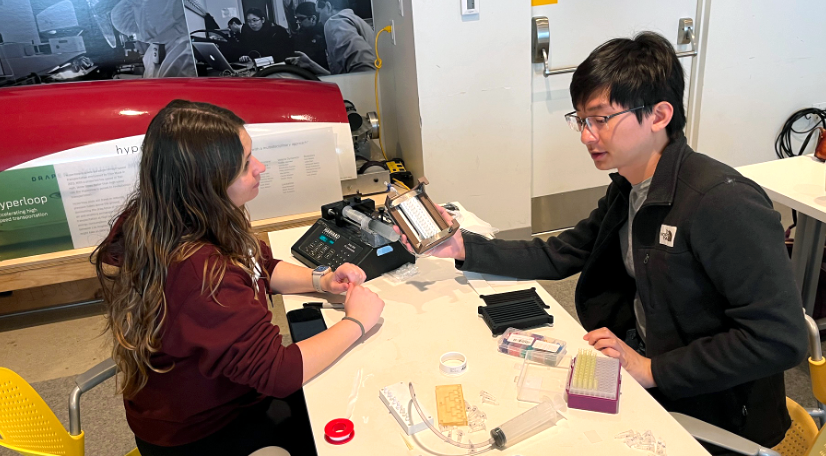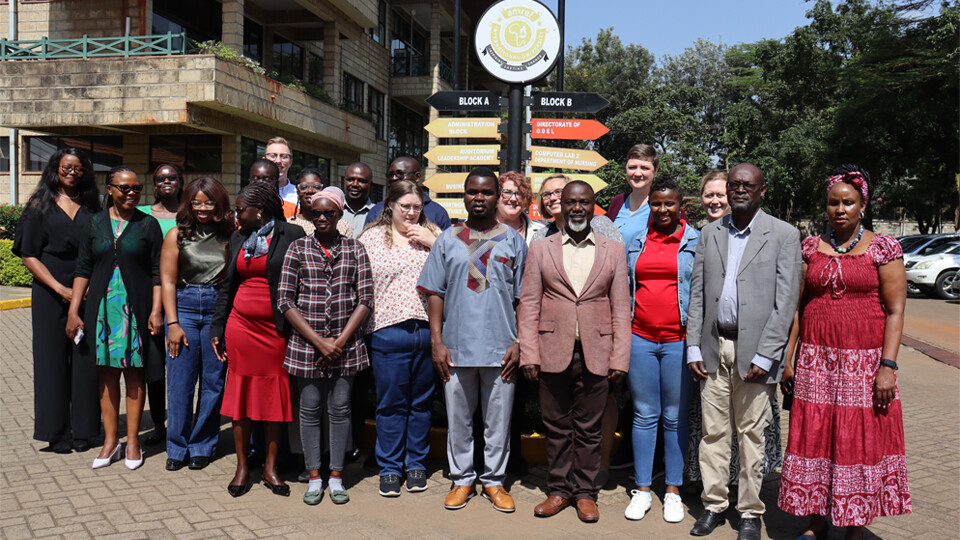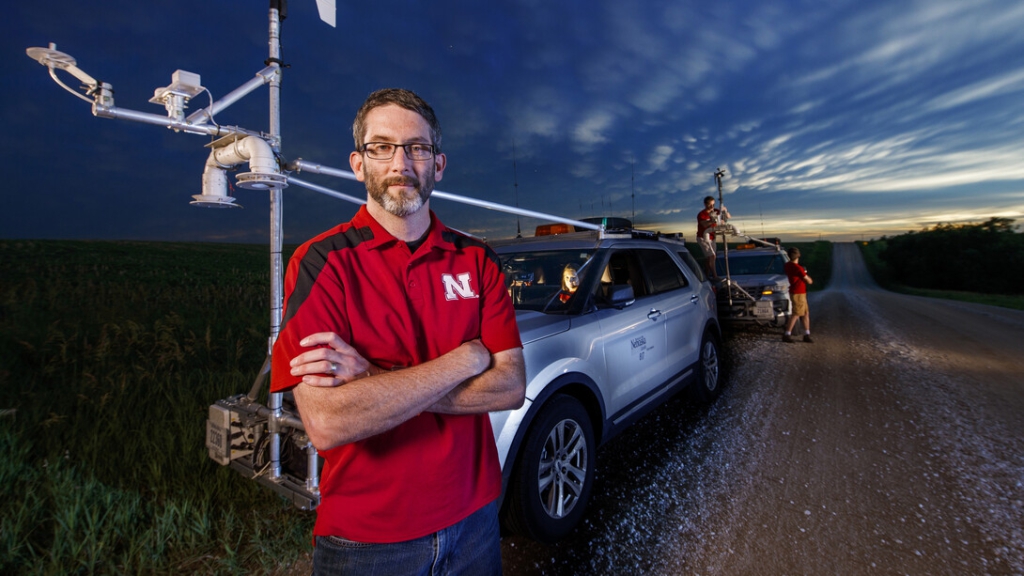Posted August 2, 2024 by Tiffany Lee
In case you missed these stories highlighting research and creative activity at the University of Nebraska-Lincoln, the Office of Research and Economic Development’s communications team has compiled a roundup of some top stories from research.unl.edu and other sources.

Nebraska team leads $1.3M project to improve youth homelessness supports
Who: Jeff Chambers, senior project director in the Center on Children, Families and the Law; Brittany Brakenhoff, CCFL research assistant professor
What: Chambers and Brakenhoff lead a project aimed at creating a statewide network to support youth experiencing or threatened by homelessness. Funded by a $1.3 million Youth Homelessness System improvement grant from the U.S. Department of Housing and Urban Development, the project will link partner organizations statewide, create systems that better identify youth in need, and improve access to necessary support services. The goal is to develop systems that ensure homelessness for Nebraska youth – which is tied to problems with mental and physical health, education, social development and well-being – is rare, brief and non-recurring.
“The most significant predictor of future homelessness is an experience of homelessness,” Chambers said. “This is trauma that should not be a part of anyone’s life. We should do all we can to prevent and end that experience for all, particularly youth, who are the future of our communities and state.”
Writer: Troy Fedderson, University Communication and Marketing

Nebraska test suggests U.S. highways are not ready for widespread EV use
Who: Cody Stolle, Ronald Faller, Bob Bielenberg and other collaborators at the Midwest Roadside Safety Facility
What: The Midwest Roadside Safety Facility recently conducted its fourth electric vehicle crash test aimed at determining whether commonly used highway guardrails and traffic barriers can reduce the risk of injury and death when an electric vehicle leaves the road. In the newest test, the researchers found that when an electric 2022 Rivian R1T pickup truck crashed into a concrete barrier commonly used as a freeway median barrier or to shield highway construction workers from traffic, the barrier suffered catastrophic damage that could put workers and bystanders at risk. The three previous crash tests produced similarly concerning results. Facility researchers are shining a light on these issues as the number of electric vehicles on the road increases.
“Our research is an aspect of safety that the auto industry might not be super cognizant of. They know guardrails are out there, but they don’t necessarily understand how their vehicles interact with them. Making them aware is the first step, in my mind,” Bielenberg said.
Writer: Leslie Reed, University Communication and Marketing

Fritz explores depths of Amazon River Basin
Who: Sherilyn Fritz, George Holmes Professor of Earth and atmospheric sciences and biological sciences
What: Fritz is a lead researcher on the Trans-Amazon Drilling Project, which will illuminate the historical factors that shaped tropical South America into one of the world’s most biodiverse regions. To uncover this evolutionary history, the team is examining sediment cores collected from two Amazon River basin sites. Fritz recently spent two weeks in Brazil, helping to prepare samples for shipment to Minnesota’s Continental Scientific Drilling Facility. The project – the culmination of nearly 10 years of work – is funded by the International Continental Drilling Program, the National Science Foundation, the Smithsonian and the Sao Paulo Research Foundation.
“We have bits and pieces of this history, but it’s a piece here and a piece there in different locations and different time periods, and (this is) one continuous record from one place,” Fritz said. “We have a lot of both physical tools as well as geochemical methods that we didn’t have 10 or 20 years ago that allow us to do things we couldn’t do, so there’s a lot of new opportunities that have opened up. Whatever we get will be eye-opening.”
Writer: Kristina Jackson, University Communication and Marketing

Novy aids development of next-generation ocean sensor system
Who: Dan Novy, assistant professor of emerging media arts
What: Novy is part of a national team developing a next-generation deep ocean sensor and camera system for the Ocean Discovery League, an organization committed to accelerating deep-ocean exploration through accessible systems. With a $1.2 million ocean technology transition grant from the National Oceanic and Atmospheric Association and the Integrated Ocean Observing system, the team will advance work on the deep-diving, low-cost Deep Ocean Research and Imaging System, or DORIS. Novy is the project’s technical adviser, helping to develop innovative technologies and experiences, both technical and creative, to enhance the system’s usability and impact. The award is one of the largest single investments in easy-to-use, low-cost technology targeting the deep sea.
“I will be collaborating with research partners and coordinating educational and creative outreach efforts, including workshops, interactive installations and training sessions, to empower communities to utilize the new technology effectively and capture the public’s imagination,” Novy said.
Writer: Hixson-Lied College of Fine and Performing Arts

Husker projects advance study of soil moisture, hydrology
Who: Trenton Franz, professor of hydrogeophysics and associate director of research for the School of Natural Resources
What: Franz’s team recently installed a neutron monitor – just the third in the U.S. and the only one outside the East Coast – at the university’s Eastern Nebraska Research, Extension and Education Center near Mead. The monitor performs the crucial task of correcting the soil moisture readings of cosmic ray neutron sensors, which are disrupted during surges of solar activity. Accurate data is key for agricultural decision-making and monitoring climate change. The National Science Foundation, Bureau of Reclamation and U.S. Geological Survey funded the new instrument. Franz’s team is also launching a new collaboration that unites hydrologists and space weather scientists, both of whom use neutron monitors. The partnership will launch in October with an NSF-funded planning conference.
“The goal for the conference is to bring together these two groups of disciplines and think about what we might do with a future generation of combined low- and high-energy neutron detectors,” Franz said.
Writer: Geitner Simmons, Institute of Agriculture and Natural Resources

NSRI, MIT Lincoln Laboratory announce strategic partnership, results of student R&D
Who: The National Strategic Research Institute at the University of Nebraska and the Lincoln Laboratory at the Massachusetts Institute of Technology
What: NSRI and the Lincoln Laboratory at MIT have formed a strategic partnership to launch a student research program that will tackle historical national security questions for the Department of Defense. The partners conducted a pilot project at MIT during 2023-24 focused on developing a device capable of culturing traditionally “uncultivable” microorganisms, which would significantly broaden the cell diversity that can be probed for bioprospecting or biomanufacturing applications. The partnership will continue to target DOD research funding to introduce students to longstanding DOD challenges and create workforce development opportunities.
“In an era of rapidly evolving dangers, we must stay ahead of the curve through continuous innovation,” said David Roberts, NSRI research director for special programs. “This partnership harnesses a unique combination of strengths from two leading academic institutions and two research institutes to create new paradigms in biological defense.”
Writer: Katelyn Ideus, National Strategic Research Institute

From Nebraska to Kenya, project aims to fulfill a Grand Challenge
Who: Julie Tippens, associate professor of child, youth and family studies; Jentry Barrett, engagement zone coordinator with Nebraska Extension; Sonya Turkman, assistant professor of interior design; Emira Ibrahimpasic, associate professor of practice and assistant director of global studies in the School of Global Integrative Studies; and collaborators in Kenya
What: The Nebraska team, including five Husker students, is in Nairobi, Kenya, to learn about forced migration-affected persons, families and communities as part of the Pamoja Project, which is funded by a Grand Challenges Planning Grant. Pamoja means “together” in Kiswahili and reflects the project’s partnership approach, which integrates expertise from various disciplines. The Husker team is meeting with Kenyan collaborators and advancing their work to study the physical and mental health of forcibly displaced communities and the policies that affect them. The students are exploring the influence of the built environment on well-being, mental health and psychosocial support. In 2025, the Kenyan research team will visit Nebraska.
“Nebraska and Kenya are perfect partners because they both host several of the same refugee populations, and many Congolese, Somali and Sudanese refugees have reached Nebraska via Kenyan camps or cities,” Ibrahimpasic said.
Writer: College of Arts and Sciences

‘Twisters’ draws from storm-chasing science led by Nebraska expert
Who: Adam Houston, professor of Earth and atmospheric sciences
What: Houston was among the scientists and weather experts nationwide who were contacted by Lee Isaac Chung, director of the summer blockbuster “Twisters,” to provide expertise on storm chasing and the science of tornadoes and supercell thunderstorms. Houston is a principal investigator on the Targeted Observation by Radars and UAS of Supercells project, which features the use of the RAAVEN drone, a 7 1/2-foot wingspan instrument that can fly as fast as 90 mph. “Twisters” features a RAAVEN, which was developed at the University of Colorado Boulder. Houston also provided Chung with information to help shape the movie’s portrayal of storm chasing scientists versus chasers from the public.
“We talked about storm chasing in general and storm chasing in science – he wanted to get a context for what that difference meant,” said Houston.
Writer: Leslie Reed, University Communication and Marketing





